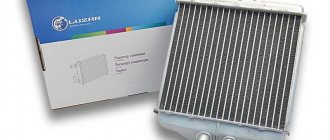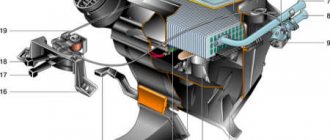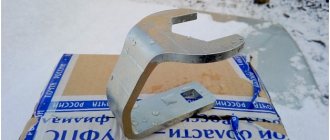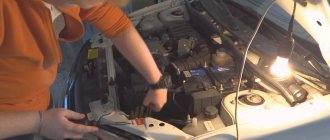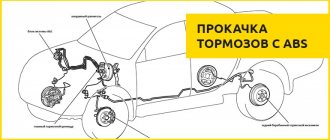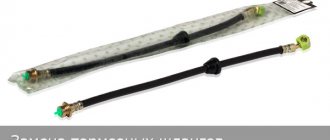How to independently adjust and replace the heater dampers on a Lada Kalina
Probably every car enthusiast eventually encounters poor heater performance.
The owners of the Lada Kalina, unfortunately, are no exception. Sometimes it is very difficult to understand the true reason for poor interior heating when a normally working heater suddenly begins to fail to cope with its task. The problem of weak heating can be solved by replacing and adjusting the heater damper on the Lada Kalina.
The result of the work done is impressive!
After this improvement was made, now we again have to forget about the existence of a second speed of operation of the heater on the highway, since even at the 1st speed the car is pleasantly warm, and sometimes even hot!
This is even if my heater motor is already running out, it creaks, squeaks, rattles every now and then... But I’ll talk about that some other time, when I do this repair, I don’t want to bother with replacing it in the cold.
If you modified your Kalina in a similar way, share your impressions, and if you have questions, write in the comments, I will be glad to help!
Probably every car enthusiast eventually encounters poor heater performance. The owners of the Lada Kalina, unfortunately, are no exception. Sometimes it is very difficult to understand the true reason for poor interior heating when a normally working heater suddenly begins to fail to cope with its task.
The problem of weak heating can be solved by replacing and adjusting the heater damper on the Lada Kalina.
What is the damper responsible for?
While the engine is running in the cooling system, the heated liquid moves through the heater radiator, while it heats the air flowing through it. The volume of air passing through the radiator and outside it is controlled by the main heater damper. Depending on how the temperature control knob is located on the dashboard, the amount of incoming air will depend.
You can distribute air movement throughout the cabin by turning the handle that regulates the position of the damper. But there are cases when the damper jams and it is impossible to properly regulate the flow of heat into the Kalina’s cabin.
If the problem is only with the valve, then you can correct the situation quite simply by tightening its cable. If after these actions the situation has not changed for the better, then you need to conduct a visual diagnosis of the condition of the mechanism and perform a number of simple steps.
How can I check the operation of the heater damper?
- Set the temperature control knob on Kalina to the extreme position of the blue sector, and the fan speed to the maximum value.
- Turn the damper control handle on the block and at the same time watch for changes in the direction of the air flow.
If the air flow remains unchanged, this indicates a breakdown of the mechanical control unit of the stove. Most likely, the rod fell off and stopped screwing onto the roller due to its malfunction. Or the second option could be that the damper is stuck. If your car has climate control, then check the damper micromotor and check the condition of the ventilation control unit, heater and air conditioner.
How to get to the damper?
To see where the central heater flap is located, you will need to partially disassemble the dashboard, and specifically, unscrew the beard. This is the location on the dashboard where the heater switches are located.
- Remove the ashtray.
- Squeeze out the 2 plugs located next to the emergency lights button.
- Remove all control knobs.
- Unscrew the 2 self-tapping screws of the center console and carefully pull it out, while prying it at the latches.
- Disconnect all wires.
- Now you can easily reach the damper.
- Replace the damper or its drive components.
Very often, the cause of the malfunction may be a broken damper drive mount. If the situation is not critical, then you can simply glue the part that has fallen off using superglue.
There are cases when the valve drive mount breaks off due to an undeveloped cable that is very difficult to lower. In this case, it must be developed manually, after which this problem should not arise.
How to adjust the heater damper on a Lada Kalina?
- The first step is to adjust the heater valve.
- Remove the bracket that holds the cable sheath to the faucet body.
- Remove the cable from the faucet lever.
- Open the tap to the maximum.
- Unhook the cable from the lever block.
- Remove the old cable.
- In the future, the tap may not be closed at all.
If you don’t like the method described above, you can use another one:
- Adjust the length of the sheath and cable so that in the extreme right position of the lever on the block the tap opens completely.
- Secure the cable located in this state using a latch.
- Then we proceed directly to adjusting the heater damper.
- Remove the bracket that holds the cable sheath on the heater body and feel for the yellow galvanized lever located on the left.
- Pull the lever towards you - this will be the maximum open state.
- Adjust the length of the cable so that in the right position of the long lever on the lever block the valve is open to the maximum.
- Lock it in.
- Do not forget that with the help of one lever both dampers are simultaneously controlled: both the tap and the large one.
Definitely, the heater in the Lada Kalina heats much better than in previous models of the VAZ automobile industry line.
Repair and replacement of faulty parts
Many novice motorists ask questions: how to remove the heater regulator on Kalina, what LED is in the heater switch on Kalina, what should be done when the heater mode switch on Kalina does not work. Answering these questions, I want to say that initially it is necessary to dismantle our entire mechanism, after which we proceed to disassembly according to the following scheme:
- First of all, disconnect the negative terminal from the battery. This is done to de-energize the system so as not to short-circuit any of the sensors during the disassembly process.
- We remove the radio and turn off the power coming from the wiring harness.
- We remove the damper switch lever, then remove the temperature regulator and the air flow distribution regulator.
- At the bottom, remove the plugs behind which there are 2 screws, unscrew the fastening screws and gradually begin to remove the instrument panel console.
- After our panel is removed, it is necessary to disconnect the power supply connectors located on the back.
- After eliminating the malfunction, assembly is carried out in the reverse order.
To carry out this work, we only need a flat and Phillips screwdriver from the tools.
Difficult or impossible switching of the temperature regulator may be due to a breakdown of the switch itself. On a Lada Kalina car, replacing the heater switch is quite easy (provided that work has previously been done to remove the heater control mechanism). On the rear console of the control panel, unscrew the four screws securing the switch block. We remove the cable fastening clamps, then remove the cables from engagement with the drive unit. We replace the broken switch and reassemble it in the reverse order. When performing this work, I give you useful advice: the location of the cables on the lever block must be marked with a marker; this is done in order to install the rods in their original places during assembly.
The dashboard of a Lada Kalina car disassembled
When the stove temperature regulator does not work on Kalina, the main reasons for the breakdown may be: a disconnected connection wire or a failure of the thermistor. Such malfunctions are treated by soldering the wire and replacing the broken element. It happens that the stove regulator on Kalina does not work due to a breakdown of the temperature sensor, which happens quite rarely. This sensor is located inside the car interior lamp. If it is found to be damaged, it must be replaced with a new one.
Visual instructions for removing the fan resistor
Answering the question about what kind of LED is installed in the stove switch in Kalina, I want to say that there are LED lamps with a power of 3 Watts and a voltage of 12 Volts. This lamp is quite enough for illumination, but some motorists install LEDs with a power of 5 Watts. This does not affect the work process, the backlight just becomes a little brighter.
Heater device Lada Kalina
Air from the street enters the air intake through the air filter. The air is then forced into the ducts by an electric fan. The interior is heated by a heater (heater radiator), which is installed under the panel. When the engine is running, heated coolant circulates through the radiator, heating the air passing through it. The amount of air passing through the radiator and bypassing it is set by the central damper. The fan speed is adjusted, as well as the heater dampers are controlled using a control unit installed on the panel.
1 — heater fan electric motor; 2 — heater fan casing; 3 — air recirculation damper; 4— air ducts; 5 — heater casing; 6 — inlet pipe of the heater radiator; 7 — heater radiator outlet pipe.
The Lada Kalina heater dampers are controlled by a mechanical control unit. When the handles on the block are rotated, the rods are wound/unwound on a special roller inside the control unit. The rods have the following purpose:
- Recirculation flap drive rod.
- Drive rod for the heated windshield flap.
- Leg heating flap drive rod.
Thus, the Lada Kalina stove dampers are controlled mechanically without the use of automation. The only electronic part in the design is an additional resistor, which, depending on the position of the handle on the heater control unit, determines the fan rotation speed. This operating principle is very simple and reliable.
Adjusting the Kalina stove damper
Depending on the configuration, the layout of the Lada Kalina stove may vary. In one case, the design of the ventilation and heating system is simple and reliable, in the other, temperature control in the car interior is controlled by automation and electronics. Let's look at the operating principle of the Lada Kalina heater in different modifications.
Heater device Lada Kalina
Air from the street enters the air intake through the air filter. The air is then forced into the ducts by an electric fan. The interior is heated by a heater (heater radiator), which is installed under the panel. When the engine is running, heated coolant circulates through the radiator, heating the air passing through it. The amount of air passing through the radiator and bypassing it is set by the central damper. The fan speed is adjusted, as well as the heater dampers are controlled using a control unit installed on the panel.
1 — heater fan electric motor; 2 — heater fan casing; 3 — air recirculation damper; 4— air ducts; 5 — heater casing; 6 — inlet pipe of the heater radiator; 7 — heater radiator outlet pipe.
The Lada Kalina heater dampers are controlled by a mechanical control unit. When the handles on the block are rotated, the rods are wound/unwound on a special roller inside the control unit. The rods have the following purpose:
- Recirculation flap drive rod.
- Drive rod for the heated windshield flap.
- Leg heating flap drive rod.
Thus, the Lada Kalina stove dampers are controlled mechanically without the use of automation. The only electronic part in the design is an additional resistor, which, depending on the position of the handle on the heater control unit, determines the fan rotation speed. This operating principle is very simple and reliable.
Climate control Lada Kalina Lux
The system design is similar to that described above, with the exception of some details. To maintain a given temperature in the cabin, two new elements are used in the design: a temperature sensor in the cabin (built into the ceiling light) and a damper micromotor reducer. Also, the mechanical control unit has been replaced with an electronic one, with degrees of air temperature in the cabin marked on it.
The operation scheme is as follows: the control unit periodically receives a signal from the temperature sensor in the cabin and compares it with the temperature set on the unit. If the difference is too large, the control unit sends a signal to the micromotor gearbox, which already controls the heater dampers (opens or closes hot air from the heater).
Interior ventilation of Lada Kalina
Air is extracted from the passenger compartment in all trim levels due to the vacuum generated near the rear of the body when the car is moving. Exhaust deflectors are built into the body under the rear bumper.
In winter, my pepelats is not as warm as it should be. In this case, the fan works normally, judging by the air flow. The thermostat is most likely working, since the engine temperature reaches one hundred and ten, and the radiator fan turns on at the same time. The heater radiator couldn't have clogged up in three years, I think. What else can you sin on? Air lock? I have never had gurgling sounds anywhere.
I decided to touch the plastic heater flap lever. Sitting on the driver's seat, I crouched down and grabbed this lever with my right hand. He extended his left hand to the base of the windshield to feel the temperature of the air flow from the blower slots. At the same time, my ear ended up near the deflectors above my beard. My observation: When I pressed the lever, the sound in the deflectors changed. And the air became warmer. It's not like the air turned fiery. Of course not. But my hand felt the difference.
Now we need to figure out how to solve this problem. I don’t like the options that I saw during the drive, when they were tinkering with rubber bands and springs. The “shit and sticks” method is, of course, good... But I want to do it once and forget. Maybe someone has some ideas? Or has anyone already gone through this stage?
Yesterday after work I used the first spring I found.
As all Lada Kalina owners already know, the heat here is simply excellent, compared to previous models of domestic cars. To make the most of your heater's power, you must set all dampers and switches correctly.
The Kalina heater control unit includes:
- Temperature regulator for the air supplied to the cabin (red - warm, blue - cold)
- Air flow power mode switch (it is recommended to operate the vehicle with 1st speed engaged)
- Regulator for changing the flow direction (up - windshield, to the right - to the torso of the driver and passenger, down - to the legs, to the left - both to the windshield and to the legs)
- Recirculation flap control. The extreme left position - air enters the cabin from the outside. The extreme right position means that no air enters the passenger compartment; this mode is recommended to be used when it is necessary to quickly warm up the car interior. You cannot constantly drive with the damper closed, as the windows will quickly fog up.
The central nozzle of the stove is also adjustable; using the slider, you can change the direction of the flow. If the slider is pushed all the way down, air blows from the center of the nozzle. And if it is raised up, then the heat will flow through the upper part of the cabin and thereby warm up the entire space faster, especially in the rear of the car.
And one more distinctive feature of the stove on Kalina is that an air duct is connected to the feet of the rear passengers, which was not the case on any of the previous VAZ models. From our own experience, we can safely say that after driving for no more than half an hour in the back seat, your legs warm up as if they were in hot water.
In severe frosts, you feel quite comfortable in the Kalina’s cabin when the heater is operating at 2nd speed and the temperature is set to maximum, but if it’s not so cold outside, it warms perfectly even in the first mode. And in order for the side windows to thaw faster in the morning, it is better to direct the side nozzles to the most extreme positions towards the windows. The pictures below show all the switches and adjustments.
Climate control Lada Kalina Lux
The system design is similar to that described above, with the exception of some details. To maintain a given temperature in the cabin, two new elements are used in the design: a temperature sensor in the cabin (built into the ceiling light) and a damper micromotor reducer. Also, the mechanical control unit has been replaced with an electronic one, with degrees of air temperature in the cabin marked on it.
The operation scheme is as follows: the control unit periodically receives a signal from the temperature sensor in the cabin and compares it with the temperature set on the unit. If the difference is too large, the control unit sends a signal to the micromotor gearbox, which already controls the heater dampers (opens or closes hot air from the heater).
Interior ventilation of Lada Kalina
Air is extracted from the passenger compartment in all trim levels due to the vacuum generated near the rear of the body when the car is moving. Exhaust deflectors are built into the body under the rear bumper.
Dear customers, in order to avoid errors when sending the gearmotor HCC D 266-SDBAA 01 (619852) Kalina 2 (white label), top-bottom damper drive, in the “Comment” line indicate your car model and year of manufacture, and with which climate control system (“Panasonic” or “HALLA”), the color of the label (blue, yellow, white) on the gearmotor.
The stove heater device is designed for an automatic microclimate control system for the VAZ 2192. Air from outside or from the passenger compartment enters the fan housing, which is helped by the fan itself. Further along the air duct, the air enters the heater housing, where its temperature is regulated and the air flows are distributed as required. For example, the flow goes to the windshield, feet or to the center of the cabin through nozzles. The operation of the heater is controlled by an electronic control unit.
The stove blows cold air on the Lada Kalina
If your Lada Kalina heater is blowing cold air, but all the equipment is working properly, there are no air locks and all sensors are normal, then you should think about the fact that most likely the problem lies in the dampers of the car’s heating system. It is quite difficult to identify this problem; usually it is discovered by the method of elimination, when all other elements of the heater have already been checked. In this article, we will talk about what usually precedes the identification of problems with the heater dampers, and also share information on how to correct such an unpleasant situation.
It is worth noting that on our website there is a publication Replacing the stove without removing the Lada Kalina panel, which describes in detail a method that will allow even a complete beginner to cope with the task.
Signs of malfunction of the heating system dampers Lada Kalina
Most owners of Lada Kalina cars note that even at a temperature of -25 degrees Celsius outside, it is enough to turn on the heater to first speed and the cabin becomes warm. At the same time, after a certain period of time, the heating intensity begins to drop, and it is no longer enough to start the heater at first speed; you have to switch to second, and sometimes even further.
The thing is that Kalina, like a number of other cars produced by VAZ, has a native “disease” - even in the most extreme position of the temperature control knob (as hot as possible), the damper does not open completely
. As a result, with minimal wear of the heater elements, the heating of the interior begins to decrease. To make sure that your car has such a problem, just look at the heater housing from the driver's seat. You will be able to see the lever of this damper, which operates with incomplete amplitude, and the cable that goes to it.
Fortunately, there is a method to fix this problem, but you will need to make some adjustments yourself, which we will discuss in the following sections of this article, but first, we will explain how to make sure that this is the problem in your particular case.
HEATER DEVICE LADA KALINA
Air from the street enters the air intake through the air filter. The air is then forced into the ducts by an electric fan. The interior is heated by a heater (heater radiator), which is installed under the panel. When the engine is running, heated coolant circulates through the radiator, heating the air passing through it. The amount of air passing through the radiator and bypassing it is set by the central damper. The fan speed is adjusted, as well as the heater dampers are controlled using a control unit installed on the panel.
The Lada Kalina heater dampers are controlled by a mechanical control unit. When the handles on the block are rotated, the rods are wound/unwound on a special roller inside the control unit. The rods have the following purpose:
- Recirculation flap drive rod.
- Drive rod for the heated windshield flap.
- Leg heating flap drive rod.
Thus, the Lada Kalina stove dampers are controlled mechanically without the use of automation. The only electronic part in the design is an additional resistor, which, depending on the position of the handle on the heater control unit, determines the fan rotation speed. This operating principle is very simple and reliable.
Statistics of malfunctions of the Lada Kalina stove
According to the results of the survey “ Why does the stove heat poorly on the Lada Kalina? » the main causes of the malfunction were identified:
- 32% voted for problems with the heater damper.
- 14% of votes were given for a faulty heater fan.
- The same number of votes (13%) were given for a failed ventilation and heating system control unit and a faulty heater radiator (replacement).
- For 9% of survey participants, the fault in the heater’s malfunction was the damper’s micromotor reducer.
The remaining votes were given for other problems with the Lada Kalina stove: a faulty additional resistor for the stove, a cabin temperature sensor and a dirty cabin filter.
Let us remind you that you can find various modifications to the car systems in the Lada Kalina tuning section.
Keywords: Lada Kalina stove | air ducts Lada Kalina | air conditioner Lada Kalina | filters Lada Kalina | Lada Kalina cooling system
+10
Share on social networks:
Found an error? Select it and press Ctrl+Enter..
CLIMATE CONTROL LADA KALINA LUX
The system design is similar to that described above, with the exception of some details. To maintain a given temperature in the cabin, two new elements are used in the design: a temperature sensor in the cabin (built into the ceiling light) and a damper micromotor reducer. Also, the mechanical control unit has been replaced with an electronic one, with degrees of air temperature in the cabin marked on it.
The operation scheme is as follows: the control unit periodically receives a signal from the temperature sensor in the cabin and compares it with the temperature set on the unit. If the difference is too large, the control unit sends a signal to the micromotor gearbox, which already controls the heater dampers (opens or closes hot air from the heater).


